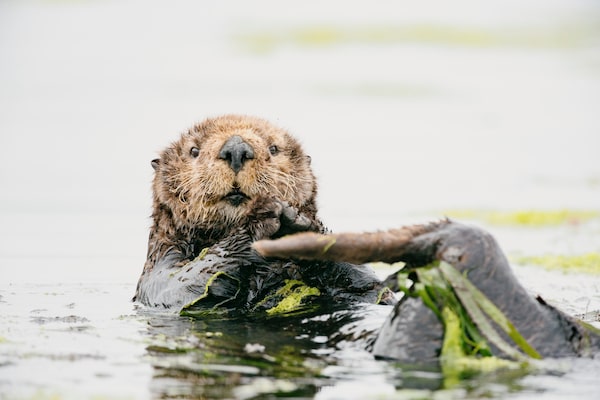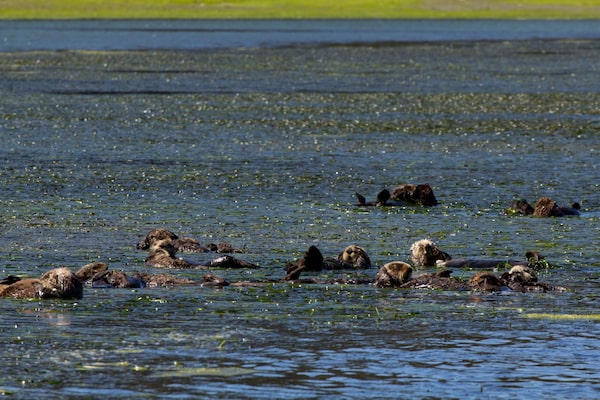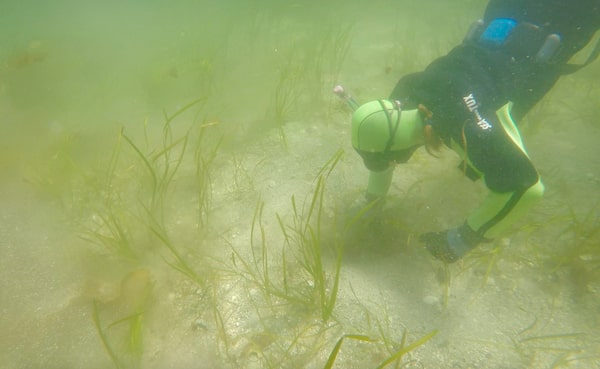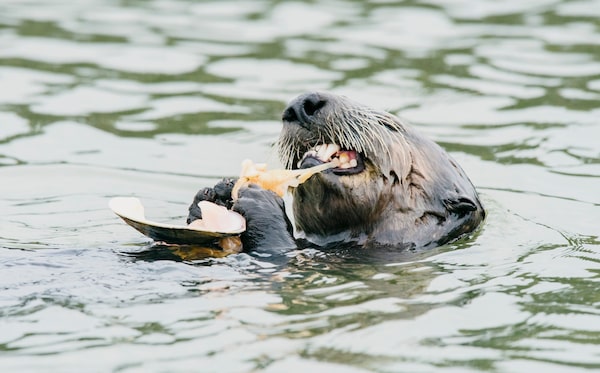
A southern sea otter grooms itself in Elkhorn Slough in California's Monterey Bay. Sea otters on the B.C. coast were wiped out by hunting in the 19th century, but later restored by animals from Alaska.Kiliii Yüyan Photography
In 1969, as the U.S. Atomic Energy Commission prepared to launch underground nuclear tests at Amchitka Island in Alaska, a romp of resident sea otters was captured and moved from harm’s way. Some of those animals were relocated to Checleset Bay, on the northwest coast of Vancouver Island.
Scientists are now charting how the descendants of those marine refugees are restoring ecological balance to a broad swath of British Columbia’s coastline.
Sea otters, hunted for their valuable pelts, had been wiped out in B.C.’s coastal waters by the end of the 1800s. The disappearance of these voracious and abundant predators led to a cascade of changes on the coast: long-lived geoduck clams flourished, while sea urchins, unchecked by predation, destroyed undersea kelp forests.
The offspring of the 89 Alaskan sea otters transplanted to B.C. waters today number more than 8,100. They are still listed as Threatened under Canada’s Species-at-Risk Act, but the population is now strong enough for researchers to measure the effect on the environment as they recolonize offshore habitats.

Sea otter range in 2017
Prince
George
Aristazabal
Island
Haida Gwaii
97
BRITISH COLUMBIA
Goose Island Group
Queen
Charlotte
Strait
Scott Islands
Quatsino Sound
Checleset Bay
Vancouver
Island
Pacific Ocean
Vancouver
Clayoquot Sound
0
100
Victoria
KM
the globe and mail, source: fisheries
and oceans canada

Sea otter range in 2017
Prince
George
Aristazabal
Island
Haida Gwaii
97
BRITISH COLUMBIA
Goose Island Group
Queen
Charlotte
Strait
Scott Islands
Quatsino Sound
Checleset Bay
Vancouver
Island
Pacific Ocean
Vancouver
Clayoquot Sound
0
100
Victoria
KM
the globe and mail, source: fisheries
and oceans canada

Sea otter range in 2017
Prince
George
Aristazabal
Island
Haida Gwaii
97
BRITISH COLUMBIA
Goose Island Group
Queen
Charlotte
Strait
Scott Islands
Quatsino Sound
Checleset Bay
Vancouver
Island
Pacific Ocean
Vancouver
Clayoquot Sound
0
100
Victoria
KM
the globe and mail, source: fisheries and oceans canada
New research published in the journal Science Magazine on Oct. 14 shows how otters digging for clams and other food are restoring the genetic diversity of eelgrass meadows in shallow coastal waters. That diversity can help these systems adapt to changing conditions, such as ocean acidification and warming waters.
Canada’s eelgrass ecosystems are widespread on the Pacific, Atlantic and Arctic coasts. They are rarely celebrated, but they nurture an astounding array of life, purify water, protect against shoreline erosion and absorb greenhouse gases.
“Eelgrass is a plant that’s foundational to so much of the life we have in the Pacific Ocean, and globally,” said lead author Erin Foster, a research associate at the Hakai Institute.
Seagrasses are in decline around the globe, but the reappearance of sea otters in B.C. waters is proving to be a positive disruption, restoring an ancient balance.
“Sea otters have likely exerted evolutionary and ecological effects on North Pacific eelgrass meadows since at least the mid-Pleistocene,” the paper states. That 700,000-year-old relationship unravelled when the otters were extirpated, and has only begun to be restored as the population recovers on B.C.’s midcoast.
Today, sea otters congregate in shallow waters along the midcoast, floating in groups known as rafts, within two kilometres of shore.

A raft of sea otters in an eelgrass meadow. Otters will link themselves together in sea plants like this so they can rest without drifting away.

Erin Foster of the Hakai Institute looks at eelgrass that's settled in the bottom of an otter pit. She's the lead author of a new paper looking at how otters have affected the plants' genetic diversity.Photos: Jess Fujii, Monterey Bay Aquarium; Carly Janusson, Hakai Institute
The paper stems from a broad collaboration of institutions, including Hakai, the University of Victoria, the University of B.C., Simon Fraser University, and Fisheries and Oceans Canada. It includes the work of two leading sea otter experts who have spent decades charting the recovery of the marine mammal’s population in B.C. The researchers dived in eelgrass meadows where otters are re-established, and meadows that are still untouched, to sample the genetic makeup of the plants.
“When you put on your mask and you go below the surface, what you see in a meadow that hasn’t had sea otters for 150 years or so is a really thick, lush meadow. It looks great,” Dr. Foster said. Eelgrass can reach two metres in height and it provides cover for juvenile salmon and crabs, and herring eggs. She has spotted more exotic creatures too, such as neon-green striped sea slugs, and the ethereal-looking hooded nudibranch.
But that lush meadow, unstressed by foraging sea otters, has reproduced through cloning. Where otters forage, their messy digging prompts eelgrass to resort to another reproductive method – flowering and setting seeds, increasing genetic variation. The scientists found those otter-disrupted meadows were 30-per-cent richer in genetic diversity, promising a greater long-term potential for that population to adapt and persist in the face of change.
Marine biologist Jane Watson prepares to dive for eelgrass samples.Gina Lemieux
Co-author Jane Watson, a marine biologist with Vancouver Island University who has studied B.C.’s otters for 35 years, has been looking for the opportunity to measure whether otter disturbance affected eelgrass genetic diversity for decades. Now, with enough otters in the water, plus the resources to conduct the research, she finally has an answer. “I’ve been watching remarkable changes to the ecosystem,” Dr. Watson said. “When I started, otters were restricted to a tiny little stretch of the west coast of Vancouver Island, and now probably half of the coastline of British Columbia has sea otters in it.”
She has visited coves where the seabed was pink with sea urchins. When the otters move in and snack on the urchins, she returns to find kelp forests flourishing. “All of a sudden, everything is kelp. The world goes from pink to brown.”
Sea otters are one of Canada’s smallest marine mammals; the males grow to 45 kilograms. Despite their size, they have a major impact on an ecosystem because of their unique body type. “They are the only marine mammal that doesn’t have blubber to keep themselves warm. What got them into trouble was this amazing fur they have, which is 200,000 hairs per square centimetre,” Dr. Watson said. Their pelts sold for exceptionally high prices. But even with that layer of warmth, otters need to eat about one quarter of their body weight in food every day. That’s a lot of clams.

An otter eats a clam foraged from the bottom of Elkhorn Slough.Kiliii Yüyan Photography
Research biologist Linda Nichol, another contributor to the research paper, has monitored the sea otter population for Fisheries and Oceans Canada since 2002. As the otters’ territory has increased, so has the rugged coast she and her teams need to explore each summer in small, open boats, darting around dangerous reefs to reach the shallow waters where otters can forage. An increase in kelp is a strong clue when they are looking for expanding otter habitat.
The population growth is encouraging, she said. “We’ve seen the sea otter population doing what was hoped for. It has reoccupied many parts of its historical habitat.” Their presence indicates a healthy ecosystem, she noted, in which they are not just predators, but prey for eagles and wolves.
There is no agreement on how many sea otters occupied B.C.’s coastal waters before they were commercially hunted, but records indicate that as many as 10,000 pelts were collected annually before the otters disappeared.
Zoologist Mary O’Connor, of the University of B.C.’s Faculty of Science, is not part of the study, but said the findings underscore the value of protecting seagrasses, which are declining worldwide. Seagrasses are one of the only flowering plants that can grow in a marine environment and they are incredibly important to Canada, she said. “Eelgrass are one of the most productive habitats in the world and the productivity goes straight into invertebrates, which we can think of as fish food. They are a superb feeding ground for young fish and birds, otters and sea lions.”
Canada, with the longest coastline in the world, needs to pay attention to the health of its abundant eelgrass environments as it adapts to climate change. Ocean systems are seeing significant challenges including acidification, sea warming and sea-level rise. Promoting genetic diversity in eelgrass, Dr. O’Connor said, can help these crucial sea nurseries ride out what the future may bring.
“It’s analogous to investing in the stock market: The more options you have, the more likely you’re going to ride out weird and unexpected events,” she said. “When we see these extreme stress events, like a heat dome or like a disturbance of some other kind, having [genetic diversity] gives the meadow a better chance of persisting through it and recovering afterwards.”
/cloudfront-us-east-1.images.arcpublishing.com/tgam/YDZR6ML2ZBCEXBNNSAQQQGULYM.jpg) Seals: Scapegoat or scoundrel?
Seals: Scapegoat or scoundrel?
Fishermen say North Atlantic seal populations are out of control and threatening fish stocks, but scientists say the greater threat is ecosystem changes due to climate change, Jenn Thornhill Verma explains
 Justine Hunter
Justine Hunter